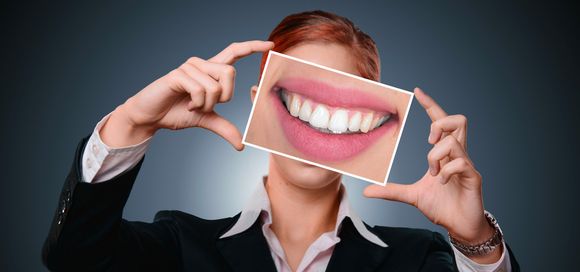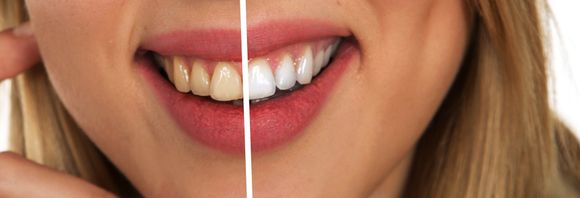Author: Sylvia Marinova, PhD student in the Genomic Stability Laboratory at BAS
How do I get radiant and shiny teeth? That's a question most of us have asked ourselves. As for his answer - there are two main ways that people resort to in search of a Hollywood smile. One is to undergo a teeth whitening procedure with a trusted dentist, and the other is to try to achieve the same results at home. In terms of both approaches, there are many misconceptions and we should not succumb to them. This article therefore aims to explain the principle of teeth whitening procedures, to consider the main arguments for and against, and to debunk some of the myths behind the shiny smile.
Why our teeth are darkening
Before explaining the essence of the teeth whitening process, you must be wondering why it comes to it at all and what is the reason why our teeth darken over time. The reasons for their change are complex and can be due to many factors.
Most often, the darkening of our teeth is the result of the natural physiological processes of aging. With age, the hard outer layer of the teeth, called enamel, wears off, and the dentin that is under it begins to see. It has a darker color and our teeth become yellower or grayer. It depends on the genetically predetermined color of dentin.
Another reason may be the intake of certain medications. The most pronounced example is antibiotics from the tetracycline group when taken in childhood, while teeth are being built. They are implemented into the mineral structure of the teeth, and the result is a light yellow or dense gray color. The degree of staining depends on the duration of use of the antibiotic, as well as on the dose.
Teeth can also change color due to external factors of our lifestyle. It can be due to poor oral hygiene and plaque accumulation, the presence of certain types of bacteria or fungi, as well as the intake of stained drinks such as coffee, red wine, tea. Smoking and the use of other tobacco products also lead to staining of teeth and the accumulation of tartar.
The change in color may be due to excessive accumulation of fluorine, as well as prolonged use of certain mouthwash containing chlorhexidine. There are other factors that are not affected in the article.
What is the teeth whitening procedure

Teeth whitening is a routine aesthetic procedure that is gaining increasing popularity. Modern whitening teething systems mainly use hydrogen peroxide [ref. 1] or its precursor urea peroxide (if reacted with water, hydrogen peroxide is again obtained). Hydrogen peroxide is a colorless liquid possessing the aggressive activity of a free radical. Therefore, it has oxidative properties on which its action is actually based. The compound penetrates through the pores of tooth enamel and reaching dentin destroys all pigments. Thus, they lose their coloration and restore the natural color of the tooth.
There are two main types of bleaching - in a dentist's office or at home. The basis of the bleaching preparation is the same, but the most significant difference is in its concentration. Which of the two methods is most suitable is determined after consultation and examination with a dentist. This step is very important, since the teeth must be completely healthy before moving on to any bleaching procedure. In addition, cleaning the tartar and polishing it is advisable to achieve maximum results. The natural pigment of the teeth is also determined by a special bloom. This helps to track the effectiveness of the selected procedure.
Performing the procedure in a dental office offers some advantages. It is carried out by a specialist, which reduces the likelihood of burning the gums. Heating or light is often used that speed up the process and the result is more easily visible.
On the other hand, bleaching at home becomes slower due to the lack of a catalyst. A low concentration of the bleaching agent is used, as this ensures safety. Often in use include special silicone splins made by your dentist. They keep the whitening gel longer on the teeth. The results are also effective and long-lasting.
It is good to know that the procedure increases the sensitivity of the teeth [ref. 2], but this discomfort usually passes on average to about four days [ref.3].
Myths and frequent delusions

There are some common misconceptions regarding teeth whitening. Here are some of the myths:
-
Teeth whitening is lifelong - this is categorically not true. The effect of bleaching lasts from several months to about three years [ref. 4]. It is important to know that duration is strongly influenced by lifestyle. For a longer-lasting effect, highly colored drinks such as tea, red wine, coffee, carbonated soft drinks, etc. should be avoided.
-
Bleaching is even - it is also a frequent delusion. Not all teeth respond equally to the procedure. Moreover, bleaching is not effective on crowns or veneers, as well as on fillings.
-
Anyone can have sparkling white teeth - the natural color of teeth varies from person to person and is genetically determined. This means that the bleaching procedure can be as effective as regaining the natural color of the tooth, which is not always pure white.
-
Jabs with oxygen water is effective - oxygen water is a 3% aqueous solution of hydrogen peroxide. Indeed, this compound is also used by dentists, what we explained above, but at a much higher concentration. Therefore, oxygen water, which can be found in pharmacies, is not strong enough. In addition, it can cause burning of the mucous membrane of the oral cavity, if it is in greater concentration.
-
It is advisable to use regular whitening toothpaste - toothpastes with a whitening effect are very abrasive, and their excessive use leads to enamel wear and increase dental sensitivity. If used, then their use should not be permanent or for a very long period of time. As for their effectiveness - they can change the color of the teeth minimally, since they do not have the ability to penetrate in depth.
-
Bleaching is harmful to tooth enamel - here the answer is not unambiguous. With naturally healthy enamel, bleaching is not dangerous, as long as it does not take place too often. If the procedure is applied more often than once a year, it is normal to experience damage.
As a summary, we can say that teeth whitening is an aesthetic procedure that should be carried out after consultation with a trusted dentist. In general, it is safe, as long as it is carried out correctly and not too often.








